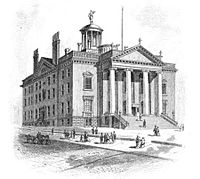51st New York State Legislature
| 51st New York State Legislature | |||||
|---|---|---|---|---|---|
|
|||||

The Old State Capitol (1879)
|
|||||
| Overview | |||||
| Jurisdiction | New York, United States | ||||
| Term | January 1 – December 31, 1828 | ||||
| Senate | |||||
| Members | 32 | ||||
| President | Lt. Gov. Nathaniel Pitcher (J), until February 11 | ||||
| Temporary President |
Peter R. Livingston (J), from February 11 to October 7; Charles Dayan (J), from October 7 |
||||
| Party control | Jacksonian | ||||
| Assembly | |||||
| Members | 128 | ||||
| Speaker | Erastus Root (J) | ||||
| Party control | Jacksonian | ||||
| Sessions | |||||
|
|||||
| 1st | January 1 – April 21, 1828 |
|---|---|
| 2nd | September 9 – December 10, 1828 |
The 51st New York State Legislature, consisting of the New York State Senate and the New York State Assembly, met from January 1 to December 10, 1828, during the fourth year of DeWitt Clinton's second tenure as Governor of New York, and—after Clinton's death—while Nathaniel Pitcher was Governor, in Albany.
Under the provisions of the New York Constitution of 1821, 32 Senators were elected on general tickets in eight senatorial districts for four-year terms. They were divided into four classes, and every year eight Senate seats came up for election. Assemblymen were elected countywide on general tickets to a one-year term, the whole Assembly being renewed annually.
State Senator Cadwallader D. Colden resigned on August 30, 1827, leaving a vacancy in the First District.
Before the time of the election in November 1827, the Democratic-Republican Party was split into two factions: the "Bucktails" (led by U.S. Senator Martin Van Buren) and the "Clintonians" (supporters of Gov. DeWitt Clinton). In view of the United States presidential election, 1828, the parties re-aligned: most of the Bucktails became "Jacksonians" (supporters of Andrew Jackson for U.S. President); and most of the Clintonians became "Adams men" (supporters of the re-election of John Quincy Adams).
On September 11, 1826, began the affair surrounding the abduction, and probable murder, of William Morgan which led to the foundation of the Anti-Masonic Party in 1828.
...
Wikipedia
